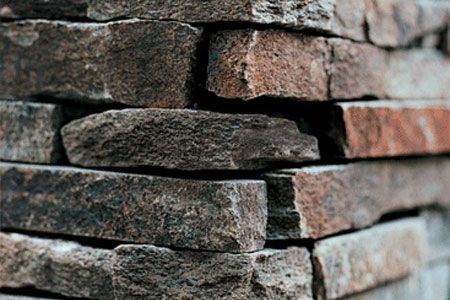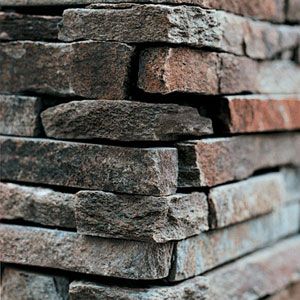
Bent over a large bucket of thinset mortar, Roger Cook reaches in with a triangular pointing trowel and scoops up a glob of the icinglike gray mix. In front of him looms a broad concrete foundation wall almost entirely covered in rows upon rows of neatly arranged stone slivers, while behind him, piled on a table, are scores of the rock pieces, looking like the wall’s crumbled mirror image.
Grabbing a slice of rock off the table, he butters its smooth back like a piece of toast. Then he turns to the wall and carefully slips the sliver into place along the 20-foot-long horizontal line. It has taken the This Old House landscape contractor nearly three days, but row by row, he’s managed to turn a cold concrete foundation face at the TV show’s Cambridge project house into a rock sculpture. Using lightweight slices of real stone, he has applied a veneer to the slab that makes the Modern-style house look as if it has grown out of an old farm wall. As Roger explains, applying stone veneer requires some patience. “Slow and careful gets the best results,” he says. “It’s all about paying attention to the details.”
Houses have been built from stone for thousands of years, but today the look of stone construction is much easier to achieve because it can be created with veneer—rock cut into thin, smooth-backed pieces that are applied to cement board or poured concrete. There’s no footing required because the pieces are relatively lightweight, ranging from 8 to 15 pounds per square foot. And the flat rear surface of the veneer simplifies mortaring, though you still need to fit stones carefully in relation to others—that’s where artistry comes in. Then, unlike solid-rock-and-mortar jobs, there’s no cure time, so you can keep right on working. Best of all, you don’t have to exhaust yourself wrestling with boulders. “You can set veneer for hours and still function at the end of the day,” says Roger.
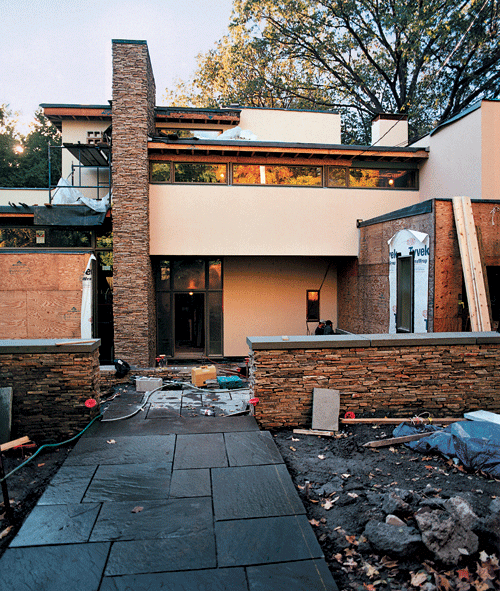
Prepping the Surface
Roger’s canvas is a clean concrete wall (painted or stuccoed concrete must be stripped and roughed up with a power chipping hammer first), but stone veneer can also go directly over cement board. Wood sheathing works as a substrate as well, but it first has to be covered with a moisture barrier, then galvanized metal lath (attached with roofing nails), and finally a thin scratch coat of mortar that has to dry overnight. Because Roger is applying a fairly heavy veneer, he starts by bolting a steel angle iron to the bottom of the concrete wall with expansion anchors to create a brick ledge—a shelf to provide support and a level starting line for the stone. To make the job go faster, he lays out dozens of pieces on a long table pulled up right next to him. “You don’t want to be fishing around in boxes while you work,” he says.
Organizing the stone is one time-saving trick, but the cut of the stone plays a large part in easing installation. At the Cambridge project house, the 450-million-year-old quartzite “Virginia ledgestone”—actually quarried in Bulgaria—gives the appearance of dry-stacked slabs. (Aside from the foundation wall, the veneer also covers the two chimneys, the front retaining wall, and the back wall of the interior stairwell.)
Jason Buechel of Natural Stone Veneers International, the Wisconsin company that supplied the stone, thinks first-time installers have an easier time with a squared and uniform profile like the Virginia ledgestone because it is less challenging to fit. “Irregular styles like fieldstone are a bit harder to get right,” he says. “It’s a good idea to hire a mason to work with you for a day or two, so you can learn.”
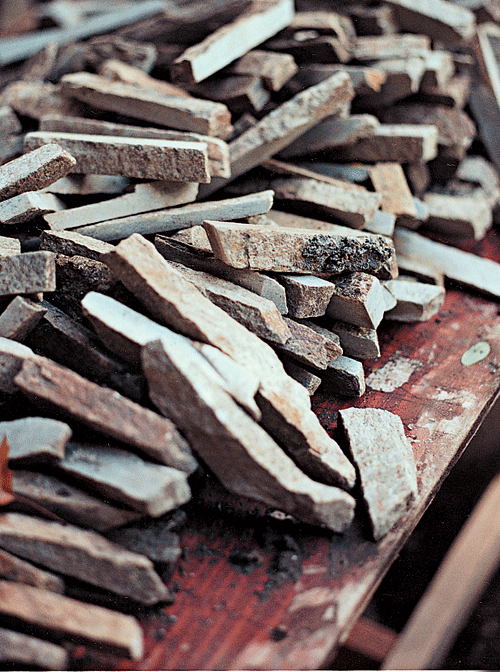
Applying the Stone
Being an old hand at stonework, Roger works solo. Starting at the inner corner, he lays stones along the brick ledge, weaving inside corners so that stones from each side alternate butting against the concrete wall. Outside corners require special right-angle cut veneer pieces that wrap around the edge and give the illusion of a whole stone. Because this job called for a dry-stack look—no visible mortar between stones—Roger can use an acrylic-fortified thinset instead of brick mortar. He spreads a 1/4-inch-thick layer of the mix on the back of a stone. After positioning the piece against the wall, he presses firmly in and down to seat it.
For the most natural look, Roger is careful to apply subsequent rows in a kind of running bond pattern, in which stones on one row span the seams between stones on the row below. He also alternates pieces of different size. “It helps to think of the veneer as full stones,” he says. “How would you lay it all out to get the best interlocking structure and design?”
After applying several rows (about 6 to 9 inches of vertical gain), Roger pauses to re-draw his guidelines, using a marker and a 6-foot level. “It’s also a good idea to stop, stand back, and take a look. Plow ahead blindly, and it’ll end up looking like the ocean,” he says, making waves with his hands.
Cleanliness is important on any masonry job, because mortar that dries on the stone face can be tough to remove. Roger keeps a bucket of clean water next to him and dips into it frequently to wipe off stones and keep his hands clean. Whenever he needs to make a cut for fit, he uses a 4-inch diamond blade on a handheld grinder, though a table-mounted tile saw would also suffice to shape the pieces. “I prefer the small grinder because you can set it right on your bench,” he says.
After letting the mortar set for 24 hours, Roger gently hoses down the wall, using a soft brush to loosen any dirt and dust. “That’s the only maintenance it should ever need,” he says.
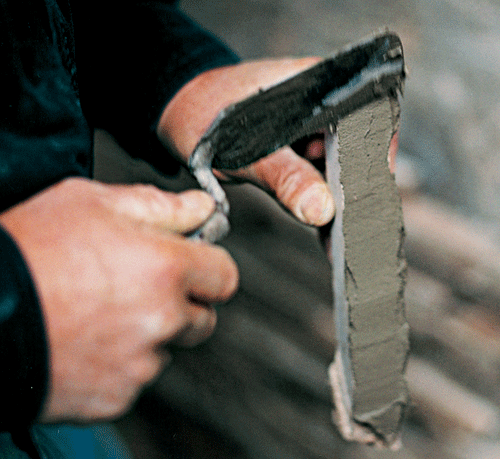
Veneer Options
A true fieldstone wall has strength, charm, and costs only $3 to $8 per square foot. But the price doesn’t take into account the thick footings needed to support it—nor the slow installation, requiring constant chiseling and shaping. One skilled mason with an assistant can lay only 15 to 20 square feet per day.
That’s why natural stone veneer—real stone that has been carefully split and sawn into thin sheets—is a growing segment of the billion-dollar stone-veneer industry. The price per square foot can be double that of full-size rocks—$8 to $14—but it goes up twice as fast, meaning real savings can be had.
More popular “manufactured” stone veneer—a mix of Portland cement, lightweight pumice, and mineral oxides for color and texture—is even cheaper and easy to install. Cast in thousands of molds and color schemes, the best manufactured stone is hard to tell from the real thing—until you pick it up and notice how light it is. Pieces can be easily cut and trimmed with a hatchet or wide-mouth nipping tool. Prices are generally in the range of $5 to $7 per square foot, uninstalled. The only drawback: With just a 30- to 50-year warranty, nothing you build with it will be quite set in stone.
